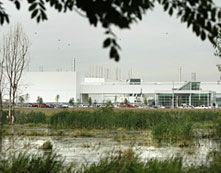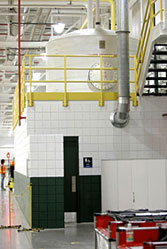Whenever GM renovates its facilities, the company works to keep them in sync with leading-edge environmental practices. That meant that when planning to build a new assembly plant, GM set out to define a plant for the future. The result: General Motor’s new LEED Gold-certified assembly plant, located in Lansing, Michigan. The Lansing plant, which started producing a number of GM’s crossover vehicles at the end of 2006, is one of the “world’s most environmentally advanced auto manufacturing plants” and is expected to save substantial amounts of energy and water over similar buildings.1 It is the first automotive plant to receive LEED certification.
The Building

GM’s Lansing Delta Township Plant was completed in 2006
Photo courtesy of General Motors
The approximately $800 million,2 2.4-million-sq-ft facility includes a body shop, general assembly, administration and visitor’s reception buildings.3 These are in addition to the stamping and paint shops which had been built previously on the site and were not included as part of the certification process.
Using 3-D technology, design engineers built virtual models that allowed them to place assembly equipment throughout the plant and, then, to “walk” through it. This process reduced the likelihood of design changes once construction was underway, which could have led to substantial time delays and additional costs.4 It also allowed GM to identify every actual energy, material and water use need throughout the facility and to tailor systems to meet those needs.
Copper's Role in Making It Green
Achieving LEED Gold certification is no small feat. To accomplish it, GM integrated a number of critical features related to the use of energy, materials, water and the site itself. In most of these areas, copper plays a supporting role, making many of the savings possible. For example, copper is the most cost-effective conductor in electrical systems, ensuring that they do not waste energy. In plumbing, copper's high recycled content, recyclability and reduced use of glues that emit VOCs all contribute to the overall sustainability of the building.
Energy and Atmosphere
In this LEED category, the building scored almost every point that was not related specifically to energy production. The energy used by each of the six buildings on the site is strictly monitored by an advanced Building Management System. As a result, the buildings are expected to be 45% more energy efficient than industry standards and lead to savings of approximately $1 million per year.5
In the area of lighting, GM reduced the total watts/sq. ft. from an allowable range of 1.3 to 2.2 to the building’s average 0.45 to 1.90.6 To achieve this, James Konkle of GM describes how they divided each building into zones. They determined that there are some areas where only machines—not people—are working, and designed a system to turn on lights only when necessary. In other areas, they found motion sensors or simple light switches to be the best method of control. Finally, they tied all zoned systems into smart panels that turn off lights if they "know" nobody is scheduled to be in a specific area and can turn on all the lights in the event of a safety issue.
Materials and Resources

Cisterns over the washrooms capture rainwater and use it, rather than potable water, for all sanitary flushing
Photo courtesy of General Motors
More than 60% of the building’s materials, including copper wire and tube, came from suppliers located within 500 miles of the location. A substantial amount of the construction materials—especially the copper products—had high amounts of recycled content. About 80% (4,000 tons) of the construction waste was diverted from the landfill.7 To ensure a healthy workspace, GM reduced or removed volatile organic compounds (VOCs) throughout the building. This led to the use of copper pipe, which obviates the solvent cements and glues needed in PVC piping applications.8
Water Efficiency
Another area of exceptional performance is the 45% (4.1 million gal) annual reduction in nonmanufacturing water use. The engineers determined the specific amounts needed of each water use. For example, they designed a 1.5-million-sq.-ft. roof over the assembly plant as a rainwater collection system which was channeled to cisterns over the washrooms and used for sanitary flushing. They also installed low-flow faucets and toilets, as well as waterless urinals. Lastly, they used motion sensors on the faucets to reduce water use during hand-washing.
The good environmental decisions made regarding Lansing Delta Township were also good business decisions. The cost to construct the plant was less than a traditional assembly plant, and its operating costs also are significantly lower.
- David Skiven, Executive Director, GM Worldwide Facilities Group
Sustainable Site
The facility's design left 50% of the site undeveloped, and 0.75 acres was set aside to preserve the existing plants and wildlife habitat. The designers worked with environmentalists to ensure that native vegetation and wildlife would continue to thrive on the property and serve as an educational model. And, the landscaping uses native or drought resistant vegetation to eliminate the need for irrigation.9
Conclusion
The project had a number of challenges, but, through a true group effort and a clear commitment to reducing the plant’s environmental impact, GM produced an exceptional building.
Noting the success of the project, USGBC’s Council President S. Richard Fedrizzi said, “We expect GM’s plant will change the way manufacturing buildings are built in the future.”10 Few will be able to argue with his statement, given that beyond the environmental benefits, the facility cost less to build, costs less to operate and provides a better work environment.And fundamental to the plant’s environmental and energy-efficiency success is its use of copper pipe and wiring. For anyone seeking LEED Gold certification, it's important to remember that many features found in GM's Lansing facility, from optimized lighting systems to rainwater collection, can easily be incorporated into other new manufacturing plants.
Footnotes
 GreenBiz.com, “GM Opens First-Ever LEED-Certified Auto Plant,” August 4, 2006.
GreenBiz.com, “GM Opens First-Ever LEED-Certified Auto Plant,” August 4, 2006. King, R.J., “3D Tech Builds GM Plant,” The Detroit News, April 11, 2004.
King, R.J., “3D Tech Builds GM Plant,” The Detroit News, April 11, 2004. Reliable Plant, "GM Opens First-Ever LEED Gold-Certified Plant."
Reliable Plant, "GM Opens First-Ever LEED Gold-Certified Plant." King, R.J., “3D Tech Builds GM Plant,” The Detroit News, April 11, 2004.
King, R.J., “3D Tech Builds GM Plant,” The Detroit News, April 11, 2004. GM, “GM Opens First-Ever LEED-Gold Certified Automobile Manufacturing Facility,” August 3, 2006.
GM, “GM Opens First-Ever LEED-Gold Certified Automobile Manufacturing Facility,” August 3, 2006. Interview with Tom Taylor, General Manager/Vice President, Vertegy an Alberici Enterprise, January 2007.
Interview with Tom Taylor, General Manager/Vice President, Vertegy an Alberici Enterprise, January 2007. GM, “GM Opens First-Ever LEED-Gold Certified Automobile Manufacturing Facility.”
GM, “GM Opens First-Ever LEED-Gold Certified Automobile Manufacturing Facility.” Interview with Tom Taylor, General Manager/Vice President, Vertegy, an Alberici Enterprise, January 2007.
Interview with Tom Taylor, General Manager/Vice President, Vertegy, an Alberici Enterprise, January 2007. GM, “GM Opens First-Ever LEED-Gold Certified Automobile Manufacturing Facility.”
GM, “GM Opens First-Ever LEED-Gold Certified Automobile Manufacturing Facility.” GreenBiz.com, “GM Opens First-Ever LEED-Certified Auto Plant,” August 4, 2006 .
GreenBiz.com, “GM Opens First-Ever LEED-Certified Auto Plant,” August 4, 2006 .
